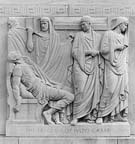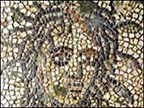 The only complete skull of a Roman militiaman to be discovered in Scotland has been used by medical experts to reconstruct the face of a 45-year-old veteran whose body ended up at the bottom of a well 2000 years ago. The soldier appeared to be of Germanic or Gallic origin. Dr John Reid, a consultant radiologist at Borders General Hospital, said: "Some people think he may have been an executed prisoner, but if so why would they throw him down a well and risk poisoning the water supply? It seems more likely he was returning from a night at the tavern, and simply fell down the well."
The only complete skull of a Roman militiaman to be discovered in Scotland has been used by medical experts to reconstruct the face of a 45-year-old veteran whose body ended up at the bottom of a well 2000 years ago. The soldier appeared to be of Germanic or Gallic origin. Dr John Reid, a consultant radiologist at Borders General Hospital, said: "Some people think he may have been an executed prisoner, but if so why would they throw him down a well and risk poisoning the water supply? It seems more likely he was returning from a night at the tavern, and simply fell down the well."
Subsection of Roman Times:
Articles about current archaeology and research into the remains of Roman and Byzantine civilizations.
Monday, March 31, 2003
A Reconstruction of Trimontium Man goes on display in Melrose
 The only complete skull of a Roman militiaman to be discovered in Scotland has been used by medical experts to reconstruct the face of a 45-year-old veteran whose body ended up at the bottom of a well 2000 years ago. The soldier appeared to be of Germanic or Gallic origin. Dr John Reid, a consultant radiologist at Borders General Hospital, said: "Some people think he may have been an executed prisoner, but if so why would they throw him down a well and risk poisoning the water supply? It seems more likely he was returning from a night at the tavern, and simply fell down the well."
The only complete skull of a Roman militiaman to be discovered in Scotland has been used by medical experts to reconstruct the face of a 45-year-old veteran whose body ended up at the bottom of a well 2000 years ago. The soldier appeared to be of Germanic or Gallic origin. Dr John Reid, a consultant radiologist at Borders General Hospital, said: "Some people think he may have been an executed prisoner, but if so why would they throw him down a well and risk poisoning the water supply? It seems more likely he was returning from a night at the tavern, and simply fell down the well."
Monday, March 24, 2003
Anglo-American Project in Pompeii Featured on the Archaeology Channel
 Pompeii is well known for its rich archaeological record sealed by volcanic deposits in A.D. 79. But what was the history of the city and its inhabitants before this date? The Anglo-American Project in Pompeii (AAPP), sponsored by the University of Bradford in England, is answering this question through scholarly research and at the same time is training future archaeologists and historians in the latest scientific field techniques.
Pompeii is well known for its rich archaeological record sealed by volcanic deposits in A.D. 79. But what was the history of the city and its inhabitants before this date? The Anglo-American Project in Pompeii (AAPP), sponsored by the University of Bradford in England, is answering this question through scholarly research and at the same time is training future archaeologists and historians in the latest scientific field techniques.
New TV documentary suggests Caesar committed suicide
 TV documentary scheduled to air today features an investigation by Colonel Luciano Garofano who suggests Caesar, through failing health, committed suicide, and orchestrated his impending murder to his advantage. He changed his will six months earlier so Marc Anthony would not succeed him on the throne, and in his place put nephew Octavian.
TV documentary scheduled to air today features an investigation by Colonel Luciano Garofano who suggests Caesar, through failing health, committed suicide, and orchestrated his impending murder to his advantage. He changed his will six months earlier so Marc Anthony would not succeed him on the throne, and in his place put nephew Octavian.
Search for "Caesar" at URL.
Prone and Decapitation Burials Found Throughout Roman Britain
Human sacrifice is often regarded as a defining feature of barbaric societies - and it took place in Roman Britain. Victims of every age, social class and sex were chosen. An exceptional proportion had a physical impairment of some kind. Overkill was normal - a single individual might, for example, be garotted, bludgeoned, drowned and have his or her throat cut before being cast into the bog. In Britain this prehistoric practice, although always a rare event, was apparently unaffected by the Roman conquest.
Most Roman burials, of course, were carried out with respect for the humanity of the deceased. Key characteristics include care for the integrity of the body - by thorough cremation or well-protected inhumation - and concern for future well-being, especially on the immediate post-mortem journey. This was expressed in the provision of food, drink, light, money for the fare and boots for walking.
A substantial minority of burials, however, show a different and darker attitude to corpses. These rough burials are often written off as careless, but the patterns are too consistent across Roman Britain for simple negligence to be the explanation. These disturbing burials include bodies that are dismembered, mutilated, bound, buried face down, decapitated, with signs of violence other than warfare, or with evidence for defleshing and exposure. The two most common variants are prone (face-down) and decapitated burials.
Most Roman burials, of course, were carried out with respect for the humanity of the deceased. Key characteristics include care for the integrity of the body - by thorough cremation or well-protected inhumation - and concern for future well-being, especially on the immediate post-mortem journey. This was expressed in the provision of food, drink, light, money for the fare and boots for walking.
A substantial minority of burials, however, show a different and darker attitude to corpses. These rough burials are often written off as careless, but the patterns are too consistent across Roman Britain for simple negligence to be the explanation. These disturbing burials include bodies that are dismembered, mutilated, bound, buried face down, decapitated, with signs of violence other than warfare, or with evidence for defleshing and exposure. The two most common variants are prone (face-down) and decapitated burials.
2000-year-old receipt for Celtic slave girl found in London
Faint scratchings on a wooden writing tablet show that a wealthy slave working for the imperial household bought a girl named Fortunata (Lucky), a member of a Celtic tribe living on the borders of Normandy and Brittany. The silver-fir tablet had been preserved in wet London soil for 2,000 years.
Friday, March 21, 2003
Overlooked Women of Byzantium Subject of Exhibit
 For the first time, an exhibit at Harvards Sackler Museum explores the world of Byzantine women: how they adorned their bodies, occupied their days, decorated their homes, and soothed their fears. Past exhibitions of Byzantine art have focused on the spirituality or imperial splendor of the Byzantine world including women only as empresses and saints. This exhibition will initiate a fresh discourse on women in Byzantium by displaying a variety of works of art and other objects and images related to them and their everyday lives.
For the first time, an exhibit at Harvards Sackler Museum explores the world of Byzantine women: how they adorned their bodies, occupied their days, decorated their homes, and soothed their fears. Past exhibitions of Byzantine art have focused on the spirituality or imperial splendor of the Byzantine world including women only as empresses and saints. This exhibition will initiate a fresh discourse on women in Byzantium by displaying a variety of works of art and other objects and images related to them and their everyday lives.
See also: http://www.nytimes.com/2003/03/21/arts/design/21COTT.html
Thursday, March 20, 2003
1st century Ivory Face of Apollo Recovered
After a six-year investigation that led authorities through Germany, Switzerland and Cyprus, the face of an ivory statue of Apollo, estimated to be from around the 1st century A.D., has been recovered in London. The fragments were originally stolen near Lake Bracciano, 10 miles northwest of Rome, seven years ago.
Tuesday, March 18, 2003
New film in new theater recreates 3rd century Roman Britain
 Using a specially-designed camera mounted on a helicopter along with site archaeologists and costumed reenactors, film makers at the Vindolanda Trusts Roman Army Museum at Greenhead in Northumberland have recreated 3rd century Roman Britain. The film is displayed in a new theater financed by a Heritage Lottery Fund grant. With the sites low ruins transformed by live action costumed shots intermingled with computer-generated graphics, visitors can see what life was really like at Roman forts like Vindolanda and others along Hadrians Wall.
Using a specially-designed camera mounted on a helicopter along with site archaeologists and costumed reenactors, film makers at the Vindolanda Trusts Roman Army Museum at Greenhead in Northumberland have recreated 3rd century Roman Britain. The film is displayed in a new theater financed by a Heritage Lottery Fund grant. With the sites low ruins transformed by live action costumed shots intermingled with computer-generated graphics, visitors can see what life was really like at Roman forts like Vindolanda and others along Hadrians Wall.
Monday, March 17, 2003
Brading Roman Villa May Be Reburied
 If enough money is not raised to replace a 100-year-old metal roof over the mosaics of Brading Roman Villa on the Isle of Wight, A spokesman for Oglander Roman Trust says the 4th century artworks discovered by Captain John Thorp, a former soldier in the British Army in India, in 1880, will have to be reburied to protect them.
If enough money is not raised to replace a 100-year-old metal roof over the mosaics of Brading Roman Villa on the Isle of Wight, A spokesman for Oglander Roman Trust says the 4th century artworks discovered by Captain John Thorp, a former soldier in the British Army in India, in 1880, will have to be reburied to protect them.
Friday, March 14, 2003
Ancient Butrint Site of Continuing Research
Butrint, previously known in ancient times as Buthrotum, lies 20 km south of the modern day port of Saranda. Settled by Corfiot traders in the 8th century B.C., this town is associated with the legend of Aeneas. The Romans used the port as a supply base for military campaigns in the Balkans in the 2nd century. The following century it became a colony for the veterans under Julius Caesar. The site was largely overlooked by archaeologists until Luigi Ugolini began excavations in 1924. He discovered a 4th century theatre, with its well preserved seating and cavea, that produced a sensation when a line of statues including the "goddess of Butrint" and a fine head of Apollo were found. Working on a huge scale, Ugolini unearthed the Temple of Asclepulus beside the theatre, a fine Roman bathblock in front of it, parts of an Early Byzantine palace by the Vivari canal, an extraordinarily well-preserved Early Byzantine baptistry with a perfectly preserved later fifth-century mosaic pavement and many other monuments. Now excavations by the Albanian Institute of Archaeology plan to concentrate on the Byzantine civilization that flourished there between 6th to 10th century A.D.
Wednesday, March 12, 2003
Learning Etruscan by Mel Copeland
The Etruscan language has been the hardest language to decipher, among those ancient languages which have been deciphered. Akkadian, Sumerian and Babylonian (cuneiform scripts), Hittite (a syllabic script) the Egyptian Heiroglyphs and the ancient Mycenaean script, Linear "B" all are profound successes in the history of deciphering ancient scripts. Of the latter two scripts, the Egyptian Hieroglyphs were deciphered by a Frenchman named J. F. Champollion. These inscriptions were in great abundance and Champollion was able to use a trilingual inscription, called the Roseta Stone, to break the code and discovered the Egyptian Heiroglyphs were written in a known language still spoken in Egypt. Michael Ventris, following his tracks, attempted to decipher the Etruscan scripts but gave up on them and focused on the more abundant scripts called Linear A and Linear B. He broke the code of Linear B and discovered that it was written in a known language, Greek. Unfortunately, there is no base, a known language, upon which we can use to make an accurate translation of the Etruscan language. Neither is there a bilingual inscription which we can use as Champollion used the Roseta Stone. There is a script, a lead tablet from La Serreta de Alcoy, dating circa. the sixth century B.C., which has many words which are familiar to the Etruscan vocabulary, and it is written with Etruscan characters.
Tuesday, March 11, 2003
Two 1st century Mummies Discovered near Rome
I saw a fascinating program on the Discovery Channel last night about two 1st century A.D. Roman mummies that were discovered in a sealed tomb just outside of Rome. Apparently, it was a mother and her 18-year-old son. Tests on hair samples of the boy revealed that his body contained over 25 times the normal amount of arsenic so researchers concluded he was poisoned. His family was very wealthy so it must have been in retaliation for something his father did. I cant imagine an 18-year-old boy (except Octavian) being enough of a threat to anyone to warrant poisoning.
The woman was wearing a very intricate hairpiece covered by a fine hairnet of gold. The hairnet was made of fine silk threads wrapped in extremely thin strips of gold. The resulting fibers were only 3 microns in diameter. A human hair is 5 microns in diameter. I wonder how such a delicate thread could have been produced?
The program also included a nicely reenacted "coming of age" ceremony where the boys bulla and striped childs toga were removed and replaced with the plain white toga virilus. It also showed him shaving for the first time then offering his first beard as a sacrifice to the gods. I noticed that his father wore a beautifully embroidered colored toga. I wonder if there is a certain age when a mature male is allowed to wear something other than the white togo virilus?
Since cremation was the usual funerary practice, researchers think this family followed the rituals of the Isis cult. The bodies both contained residuals of myrhh and the woman exhibited evidence of heat in the abdominal cavity. Researchers believe this was a result of the abdominal cavity being filled with hot pitch. The woman was wearing a beautiful ring with a tiny intricately carved bust of an older woman assumed to be her mother, covered with glass. It produced almost a ghost-like image. The researchers were even able to study the funeral garlands. Analysis of pollen grains revealed that both people had been covered with garlands of roses, violets, and lillies. This also indicated they both died in the late spring.
Their sarcophagi were made of beautifully carved marble although the mothers casket was not as carefully done as her sons.
The program repeats Saturday, March 15 at 5 p.m. EST (US).
Also, the topic of Unsolved History this week (Wednesday night) is The Colosseum. Researchers and hydraulic engineers are going to try to determine if the Colosseum could have been flooded for mock naval battles as reported by ancient sources.
The woman was wearing a very intricate hairpiece covered by a fine hairnet of gold. The hairnet was made of fine silk threads wrapped in extremely thin strips of gold. The resulting fibers were only 3 microns in diameter. A human hair is 5 microns in diameter. I wonder how such a delicate thread could have been produced?
The program also included a nicely reenacted "coming of age" ceremony where the boys bulla and striped childs toga were removed and replaced with the plain white toga virilus. It also showed him shaving for the first time then offering his first beard as a sacrifice to the gods. I noticed that his father wore a beautifully embroidered colored toga. I wonder if there is a certain age when a mature male is allowed to wear something other than the white togo virilus?
Since cremation was the usual funerary practice, researchers think this family followed the rituals of the Isis cult. The bodies both contained residuals of myrhh and the woman exhibited evidence of heat in the abdominal cavity. Researchers believe this was a result of the abdominal cavity being filled with hot pitch. The woman was wearing a beautiful ring with a tiny intricately carved bust of an older woman assumed to be her mother, covered with glass. It produced almost a ghost-like image. The researchers were even able to study the funeral garlands. Analysis of pollen grains revealed that both people had been covered with garlands of roses, violets, and lillies. This also indicated they both died in the late spring.
Their sarcophagi were made of beautifully carved marble although the mothers casket was not as carefully done as her sons.
The program repeats Saturday, March 15 at 5 p.m. EST (US).
Also, the topic of Unsolved History this week (Wednesday night) is The Colosseum. Researchers and hydraulic engineers are going to try to determine if the Colosseum could have been flooded for mock naval battles as reported by ancient sources.
The Tomb of Neros Secretary Uncovered Near The Vatican
Tombs from the time of the Emperor Nero have been unearthed as the Vatican tries to clear space for an underground car park. Among the graves is the tombstone of Neros secretary, along with well-preserved urns and amphorae. Officials denied the car park plans would threaten the discovery.
Wednesday, March 05, 2003
684 Species of Plants recorded in Colosseum survey
Building on the first plant survey conducted by Italian doctor, Domenico Panaroli, in 1643, and subsequent surveys in the nineteenth and twentieth centuries, a research team led by Giulia Caneva of the University of Rome found the variety of plant species peaked in 1855, with 420, and declined to 242 today. About 200 of these were ever-present. The research team discovered that as the use of the amphitheatre changed, agricultural weeds gave way to opportunists associated with disturbed ground. They also identified a steady influx of exotic alien varieties.
Tuesday, March 04, 2003
Caroline Wilkinson, medical artist from the University of Manchester, reconstructs the Spitalfields woman
 "Her perfectly preserved skeleton told us that she was young and slender while oxygen isotopes locked within her teeth showed that she was born not in Britain but in warmer, Mediterranean lands. Dressed in silk and gold, her head on a pillow of bay leaves and lying in a decorated lead coffin, she took with her on the final journey to the underworld her trappings of worldly wealth, vessels and ornaments of glass and jet."
"Her perfectly preserved skeleton told us that she was young and slender while oxygen isotopes locked within her teeth showed that she was born not in Britain but in warmer, Mediterranean lands. Dressed in silk and gold, her head on a pillow of bay leaves and lying in a decorated lead coffin, she took with her on the final journey to the underworld her trappings of worldly wealth, vessels and ornaments of glass and jet."
See also: The Spitalfields Dig
The Orpheus Pavement May Never Be Displayed Again
 The Orpheus pavement, which lies buried deep beneath Woodchester churchyard, was part of a fourth century Roman villa and at more than 2,200 square feet in size is believed to be the largest surviving mosaic in Northern Europe. But, damaged by fire and grave-digging above it, the mosaic may never be put on public view again.
The Orpheus pavement, which lies buried deep beneath Woodchester churchyard, was part of a fourth century Roman villa and at more than 2,200 square feet in size is believed to be the largest surviving mosaic in Northern Europe. But, damaged by fire and grave-digging above it, the mosaic may never be put on public view again.
Troy geologic studies released
John C. Kraft, H. Fletcher Brown Professor of Geology writes in the February 2003 issue of the journal Geology, which is published by the Geological Society of America, that the areas sedimentology and geomorphology do indeed complement the features described in Homers Iliad. An epic poem and a classic of world literature, the Iliad recounts portions of the war between Greece and the city-state of Troy.
"The reality of Homers description of place, event and topography correlated with geologic investigation helps show that the Iliad is not just a legend but regularly consistent with paleogeograhic reconstruction," concluded the research team, which also included George Rapp of the University of Minnesota, Ilhan Kayan of Ege University in Izmir, Turkey, and classical scholar John V. Luce of Trinity College in Dublin, Ireland. Given the vivid images painted by Homer, Kraft said he believes the author had seen the landscape firsthand. "Homer was certainly there, from the power of his descriptions," Kraft said, laying aside speculation by some scholars that the poet was blind. "You cant have really detailed descriptions of areas without having seen them."
"The reality of Homers description of place, event and topography correlated with geologic investigation helps show that the Iliad is not just a legend but regularly consistent with paleogeograhic reconstruction," concluded the research team, which also included George Rapp of the University of Minnesota, Ilhan Kayan of Ege University in Izmir, Turkey, and classical scholar John V. Luce of Trinity College in Dublin, Ireland. Given the vivid images painted by Homer, Kraft said he believes the author had seen the landscape firsthand. "Homer was certainly there, from the power of his descriptions," Kraft said, laying aside speculation by some scholars that the poet was blind. "You cant have really detailed descriptions of areas without having seen them."
Byzantine treasure trove unearthed near Alexandria
A hoard of gold pieces and bracelets dating back to the reign of the emperor Justinian has been found by a Hungarian team working in Abu Seir in western Alexandria.
Sacrificing Truth: Archaeology and the Myth of Masada
Nachman Ben-Yehuda, a professor in the department of sociology and anthropology at Hebrew University in Jerusalem, accuses Yigael Yadin, celebrated Israeli soldier turned archaeologist who died in 1984, of deliberately distorting his findings to "provide Israelis with a spurious historical narrative of heroism." Yadin ignored damning information about the rebels, Ben-Yehuda charges, pointing out that they belonged to a radical sect known for assassinating both Romans and Jews.
Monday, March 03, 2003
Ancient Romans Had a Different Take On Love
A professor of Classics at Hamilton College asked her students to compare the sentiments expressed in modern valentines with the love poetry of ancient Rome. They discovered a sharp contrast to some of the modern "mushy" sentiments such as "I love all that we share. I love the laughter, the understanding, and the fact that so much about us -- our minds, our bodies, our hearts, our feelings -- should touch so closely and perfectly together. I love how gentle and how sensitive you are."
Roman lovers described themselves as wounded, wretched, enslaved by their lovers, having their bone marrow on fire and suffering from double vision. They melded coarse obscenities with deepest expressions of sexual, erotic longing. Requited love is rarely mentioned since it was not very compelling to hear or to write about."
Roman lovers described themselves as wounded, wretched, enslaved by their lovers, having their bone marrow on fire and suffering from double vision. They melded coarse obscenities with deepest expressions of sexual, erotic longing. Requited love is rarely mentioned since it was not very compelling to hear or to write about."
Long-buried Villa of the Papyri Now Open To The Public
Although only a small fraction of the once sumptuous villa at Herculaneum which belonged to the father-in-law of Julius Caesar has been excavated, small groups of visitors will be allowed to tour the site on weekends. The sprawling villa once occupied 30,000 sq feet overlooking the Bay of Naples. It was adorned by hundreds of bronze and marble statues and stocked with a vast private library of texts written on papyrus scrolls -- from which it derives its name.
See also: http://www.humnet.ucla.edu/humnet/classics/philodemus/philhome.htm
See also: http://www.humnet.ucla.edu/humnet/classics/philodemus/philhome.htm
Subscribe to:
Comments (Atom)